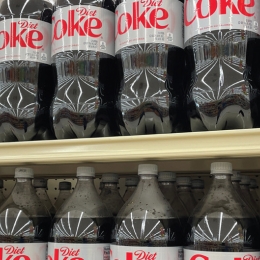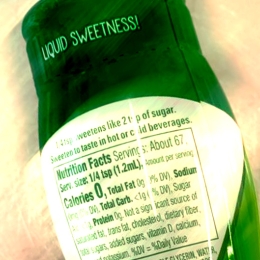Chemical Cuisine Rating
Avoid
Purpose: Artificial Sweetener
Health Concerns: Cancer
Found in: Aspartame is found mainly in products listed as "Diet," "no sugar added," "sugar-free," including soft drinks, drink mixes, gelatin desserts, frozen desserts, jams and fruit spreads, yogurt, breakfast cereal, candy, chewing gum, condiments, packaged (tabletop) sweeteners.
Aspartame (sometimes marketed under the brand names Equal or AminoSweet) is a chemical combination of two amino acids and methanol. Questions of cancer and neurological problems, such as dizziness or hallucinations, have swirled around aspartame for decades. A key 1970s industry-sponsored study initially sparked concerns that aspartame caused brain tumors in rats, but the FDA convinced an independent review panel to reverse its conclusion that aspartame was unsafe. The agency then approved its use in 1981 for use as a tabletop (packaged) sweetener and in breakfast cereals, powdered beverage mixes, and other dry packaged foods. Two years later FDA approved aspartame for use in soft drinks, by far the biggest and most lucrative market. Aspartame dominates the diet soft drink market, and the overall market for artificial sweetener, although its use is declining.
The California Environmental Protection Agency and others have urged that independent scientists conduct new animal studies to resolve the cancer question. In 2005, researchers at the Ramazzini Foundation in Bologna, Italy, conducted the first such study. The study found that rats exposed to aspartame starting at eight weeks of age and continuing through their entire lifetimes developed lymphomas, leukemias, and other tumors, including kidney tumors, which are extremely rare in the strain of rat used. In 2007, the same researchers published a follow-up study that exposed rats to aspartame beginning in the womb and continuing through their entire lifetimes. That study, too, found that aspartame caused leukemias/lymphomas, as well as mammary (breast) cancer. Then in 2010, they published a study that exposed mice to aspartame, starting in the womb and continuing throughout their entire lifetimes. That third study found that aspartame caused liver and lung cancer in male mice.
Those new studies may have found problems that earlier company-sponsored studies did not because the newer studies used far more animals and thus were more capable of detecting adverse effects. Also, the Italian researchers monitored the animals for their entire lifetimes: as long as three years for the rats and two and one-half years for the mice, instead of just two years in the company-sponsored studies (Most chemicals are tested for just two years.) Two-year-old rats are roughly equivalent to 65-year-old people. The many tumors that occurred after two years would never have been seen in industry’s studies. Furthermore, two of the new studies included exposure before birth, which increased their ability to detect cancer (only one of the industry studies did).
The food industry, FDA, and the European Food Safety Authority contest the Italian findings, pointing to what they consider serious flaws in the design and conduct of the study and evaluation of the results. However, scientists at the Center for Science in the Public Interest and elsewhere, citing evaluations sponsored by the U.S. National Toxicology Program and the Environmental Protection Agency, found industry's and EFSA’s allegations to have little merit.
Notably, after questions were raised about the Italian laboratory’s accuracy in diagnosing lymphomas/leukemias in rats, a study published in 2020 using state-of-the-art diagnostic methods confirmed 92% of the diagnoses of lymphomas/leukemias in the second (2007) rat study, and the occurrence of the lymphomas/leukemias remained statistically significant.
As one defense of aspartame, industry and FDA point to a 2006 human study by U.S. National Cancer Institute researchers. That study involved a large number of adults 50 to 71 years of age over a five-year period. The study did not find any evidence that aspartame posed a risk. However, the NCI study had three major limitations: It did not involve truly elderly people (the Italian studies monitored rodents until they died a natural death), the subjects had not consumed very much aspartame or for very long, and it was not a well-controlled study (the subjects provided only a rough estimate of their aspartame consumption, and people who consumed aspartame might have had other dietary or lifestyle differences that obscured the chemical’s effects).
Meanwhile, the most careful long-term study of aspartame in humans, conducted by researchers at the Harvard School of Public Health, found the first human evidence that aspartame poses a slightly increased cancer risk to men, but not women. The researchers speculated that that might be due to the fact that men have higher levels of an enzyme that converts methanol (a breakdown product of aspartame) to formaldehyde, a human carcinogen. The Harvard study couldn't prove that aspartame was a carcinogen, but it certainly added to the safety concerns, especially since the cancers observed in the human study (multiple myeloma and non-Hodgkin's lymphoma) were similar to the cancers observed in two of the three animal studies (leukemias and lymphomas). Another study by researchers with the American Cancer Society, not quite as large as the Harvard study, did not find any link.
The bottom line is that three independent studies have found that consumption of aspartame causes cancer in rodents, and one epidemiology study found evidence that aspartame increases the risk of cancer in men. This evidence and the recent confirmation of the findings of the Ramazzini studies has led to renewed calls by scientists that national and international agencies urgently reexamine the risk of aspartame, especially the risks of exposures before birth and early in life. That should be reason enough for the FDA and other governments to eliminate aspartame from the food supply. Meanwhile, consumers should read labels carefully and avoid this artificial sweetener).
Another concern about aspartame emerged in 2010, when Danish researchers linked the consumption of artificially sweetened soft drinks, but not sugar-sweetened soft drinks, to preterm delivery of babies. In 2012 another study, this time conducted in Norway, corroborated that finding. However, it also found a link between sugar-sweetened beverages and preterm delivery. Though the studies couldn’t distinguish between the various artificial sweeteners, aspartame and acesulfame potassium were the most widely used ones in those countries. The fact that two large, independent studies found a link between artificially sweetened beverages and preterm delivery is troubling. Pregnant women should make a special effort to avoid or at least cut back on aspartame and acesulfame K, as well as moderating their consumption of added sugars.
Since aspartame was first used, some people have contended that it causes headaches or dizziness. Some small studies have documented that finding, while others did not. Anyone experiencing such problems should simply avoid aspartame.
Two separate arms of the World Health Organization (WHO) reviewed aspartame in June-July 2023. WHO’s International Agency for Research on Cancer (IARC) evaluated whether aspartame poses a carcinogenic hazard to humans. IARC classified aspartame as “possibly carcinogenic to humans”. The Joint Food and Agriculture Organization/WHO Expert Committee on Food Additives (JECFA) evaluated the overall risk, including cancer and other health effects, posed by aspartame. CSPI will further evaluate the outcomes of both of these evaluations on aspartame’s safety and provide additional updates forthcoming.
Back to Chemical Cuisine











